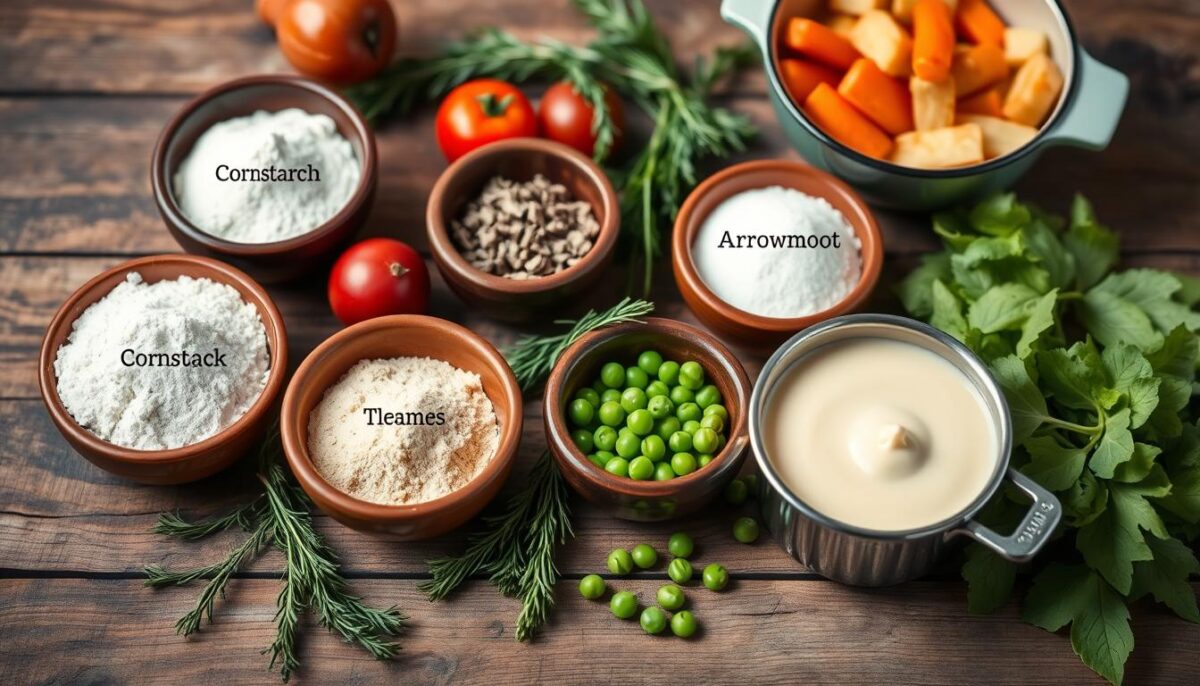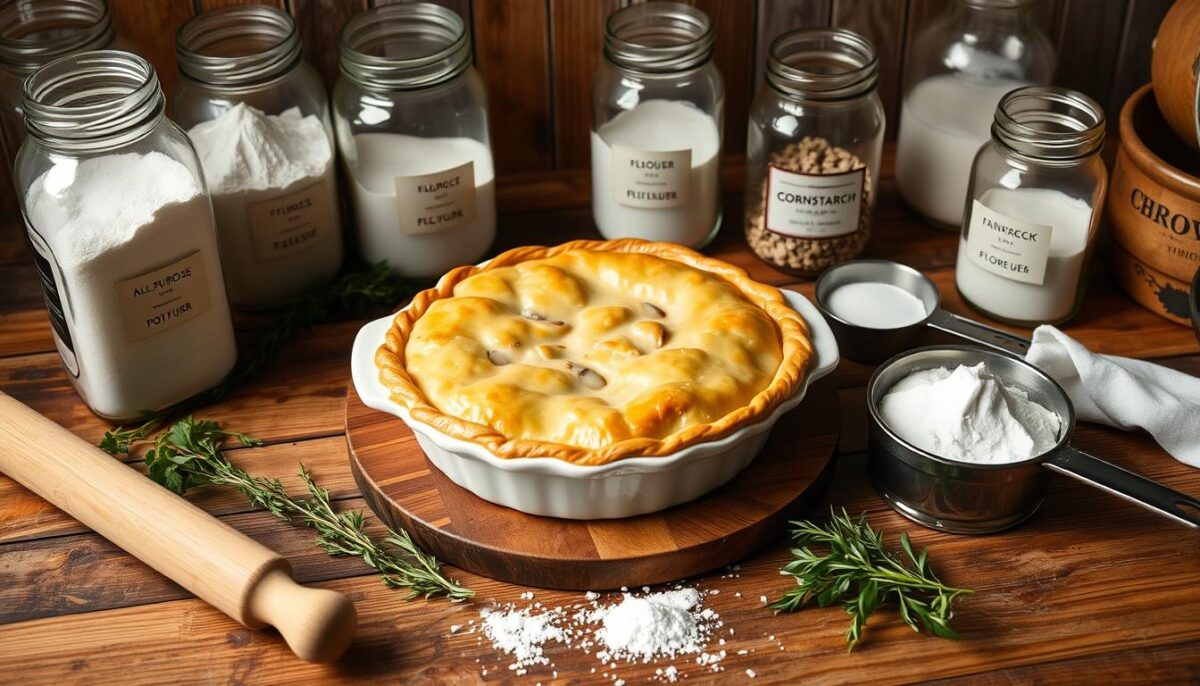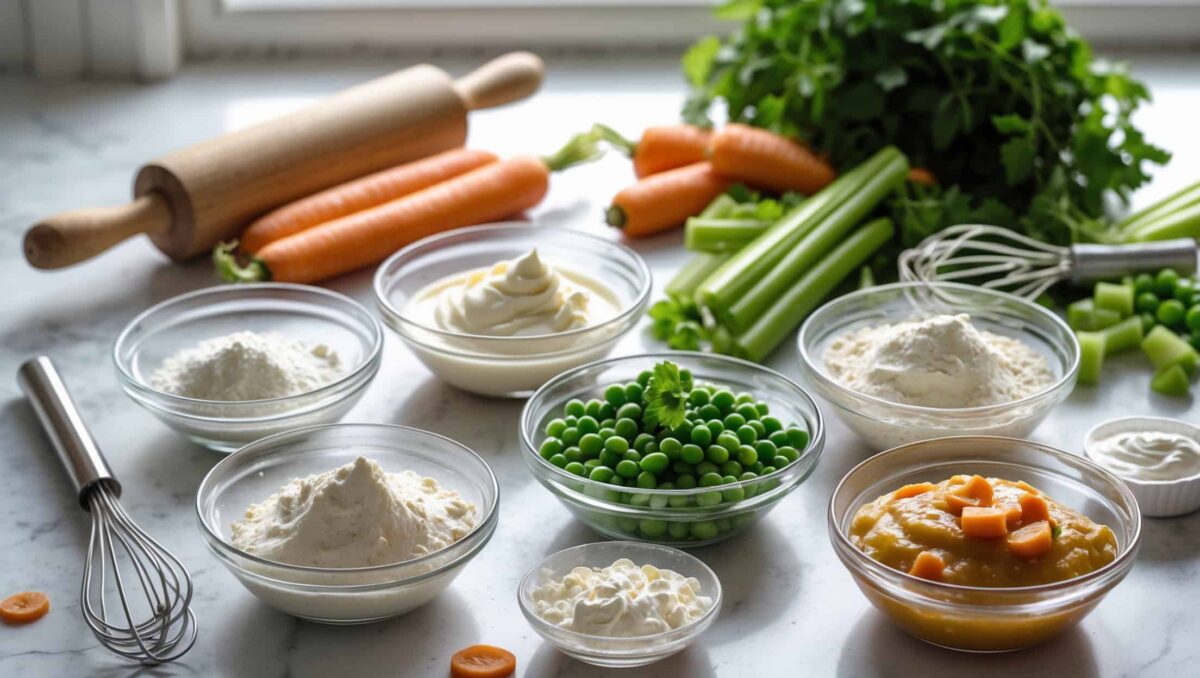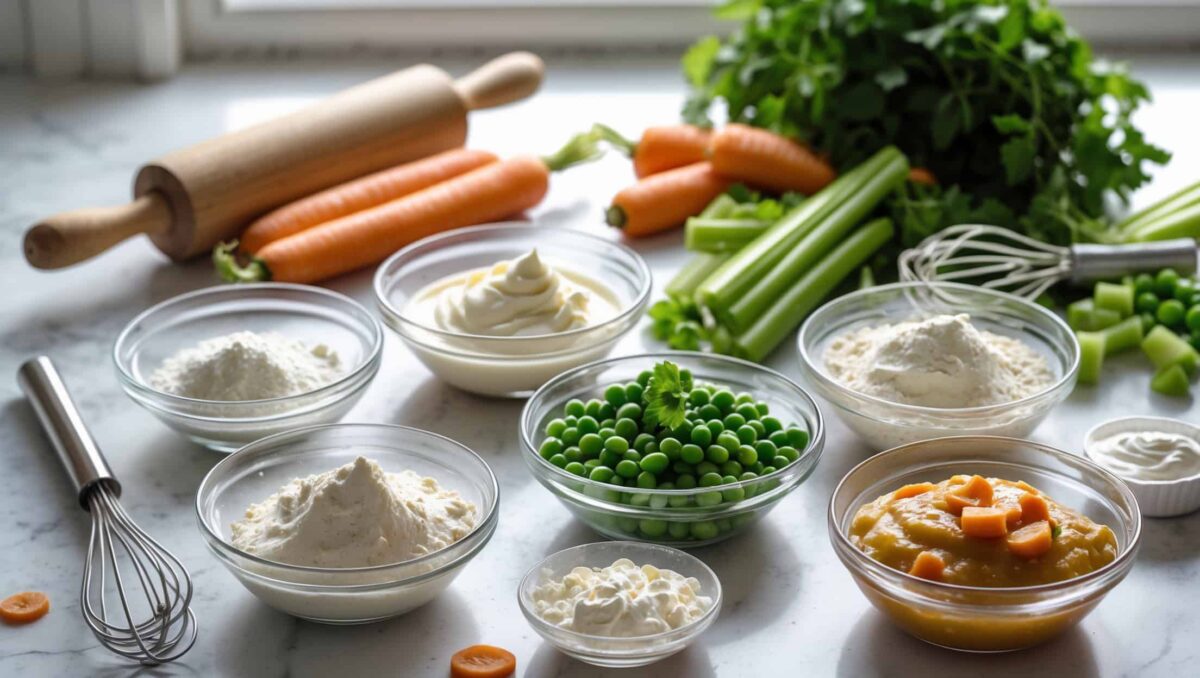When making delicious pot pies, the thickening agent is key. The right one can change the texture and taste of your pie. With many options, picking the best can be tough. We’ll look at the best thickening agents for pot pies in this article.
Whether you’re an experienced baker or new to cooking, knowing about thickening agents is important. We’ll talk about everything from traditional flour to new starch-based thickeners. You’ll learn about the best thickener for pot pie and what makes a great thickening agent.

1. Understanding the Role of Thickening Agents in Pot Pies
Thickening agents are key to getting the right consistency and texture in pot pies. There are many pot pie thickener options out there. It’s important to know how they work and what they do to the filling. Thickening agents for savory pies are crucial for the dish’s flavor and texture.
Choosing the right thickening agent depends on several things. The type of filling, the desired consistency, and how you cook it all matter. Common thickening agents for savory pies include flour, cornstarch, and tapioca starch.
Why Thickening Agents Matter
Thickening agents are important because they balance the filling’s flavors and textures. A good thickener can make the pot pie taste and feel better. But a bad choice can ruin the dish.
The Science Behind Thickening
Thickening works through a science called starches and liquid interaction. When starches heat up, they soak up liquid and grow. This makes the filling thicker, which is what we want in pot pies.
Impact on Flavor and Texture
The effect of thickening agents on flavor and texture is huge. A good thickener can bring out the filling’s flavors. But a bad one can hide or even ruin them. The filling’s texture is also key, as it makes the dish more appealing.
2. All-Purpose Flour: The Classic Choice
All-purpose flour is a favorite for thickening pot pie filling. It’s important to know how flour works in this process. This versatile ingredient helps get the perfect consistency in pot pies.
Using all-purpose flour is easy. Just mix it with a bit of water or broth to make a slurry. Then, add this slurry to the filling to thicken it. Here are some pot pie thickening tips:
- Use the right ratio of flour to liquid to avoid a lumpy or too-thick consistency.
- Cook the slurry for a few minutes to remove any raw flour taste.
- Whisk constantly to prevent lumps from forming.
By following these tips and using all-purpose flour, you can make a delicious pot pie filling. It’s great for both seasoned cooks and beginners. With a bit of practice, you’ll soon be making perfect pot pies.
3. Cornstarch as a Thickening Agent
Cornstarch is a favorite for thickening pot pie fillings. It’s quicker and more even than flour. When choosing between cornstarch and flour, think about the texture and taste you want.
Using cornstarch has its perks. It doesn’t change the flavor much and thickens well. To avoid lumps, mix it with liquid before adding it to the filling. This makes the filling smooth and tasty.
But, there are mistakes to watch out for with cornstarch. Too much or not cooking it enough can make the filling too thick or odd. With a few tips, you can make a great pot pie filling with cornstarch.
Benefits of Using Cornstarch
- Neutral flavor
- High thickening power
- Quick and easy to use
Proper Cornstarch Techniques
To use cornstarch well, follow some key steps. Mix it with liquid before adding it to the filling. Then, cook it until it reaches the right texture.

4. Alternative Starch-Based Thickeners
Looking for the best pot pie thickener? Many turn to starch-based alternatives. These options can give your filling a special texture and taste. Tapioca starch and arrowroot powder are two favorites. Tapioca starch makes fillings smooth and creamy. Arrowroot powder is perfect for those who need a gluten-free choice.
Using these thickeners has many benefits:
- Improved texture: They make your filling smooth and creamy.
- Gluten-free options: They’re great for those with dietary restrictions.
- Unique flavor: They add a special taste to your filling.
To pick the right thickener, think about your filling and desired texture. A bit of experimentation can help you find the perfect starch-based thickener.
5. What is the Best Thickening Agent for Pot Pie?
Choosing the right thickening agent for pot pie is key. It can make the filling rich and velvety. Thickening agents for pot pie are important for texture and flavor.
We’ll look at thickening agents like all-purpose flour, cornstarch, and more. We’ll talk about their benefits and drawbacks. This will help you choose the best for your pot pie.
For a great pot pie, pick a pot pie gravy thickener that fits the filling. Some top picks are:
- All-purpose flour: A classic choice for thickening pot pie fillings
- Cornstarch: A versatile and effective thickening agent
- Arrowroot powder: A gluten-free alternative for those with dietary restrictions
Professional chefs often mix different thickening agents for the best consistency. Knowing your options can help you make a pot pie that wows.
Whether it’s a meat-filled or vegetarian pot pie, the right thickener matters. With some trial and error, you’ll find the perfect pot pie gravy thickener to enhance your dish.
| Thickening Agent | Benefits | Drawbacks |
|---|---|---|
| All-purpose flour | Easy to use, inexpensive | Can be lumpy if not mixed properly |
| Cornstarch | Effective thickener, gluten-free | Can be too thick if overused |
| Arrowroot powder | Gluten-free, easy to digest | Can be expensive, limited availability |

6. Proper Techniques for Thickening Pot Pie Filling
TTo achieve the perfect consistency in your pot pie, choosing the right thickener is essential. The thickener you select depends on your filling type and personal taste. Common choices include all-purpose flour, cornstarch, and other starch-based thickeners. For tips on other pie thickening techniques, check out our Best Thickener for Pie guide.
When adding a thickener to your pot pie filling, it’s important to mix it correctly to avoid lumps. Start by combining the thickener with a small amount of cold water or broth until it’s smooth. Then, slowly incorporate it into the filling. This ensures the filling remains smooth and consistent.
Be mindful of the amount of thickener used: too little, and the filling will be too runny; too much, and it will become overly thick.
- Mix the thickener correctly: Combine it with cold water or broth first, then add it to the filling.
- Cook the filling slowly: Use low heat to help the thickener dissolve evenly and avoid clumping.
By following these tips and choosing the right thickener for your pot pie, you’ll achieve the perfect consistency. Remember to always use high-quality ingredients and cook the filling slowly for the best results. If you’re also interested in gluten-free options, try our Gluten-Free Apple Pie recipe for a delicious twist.
7. Troubleshooting Common Thickening Problems
Even with the best thickening agents and techniques, problems can still arise when making pot pies. To achieve the perfect filling, it’s essential to know how to thicken pot pie filling and follow valuable pot pie thickening tips. Common issues include lumpy sauce, runny fillings, and thick and pasty texture, which can be frustrating and affect the overall quality of the dish.
Identifying the problem is the first step in fixing it. For instance, if the sauce is lumpy, it may be due to insufficient stirring or the wrong ratio of thickening agent to liquid. On the other hand, runny fillings can result from too little thickening agent or excessive liquid. By understanding the cause of the problem, you can apply the right solution to fix it.
Fixing Lumpy Sauce
To fix lumpy sauce, try whisking it vigorously or straining it through a fine-mesh sieve to remove any lumps. You can also add a little more liquid to thin out the sauce and then re-thicken it with a small amount of thickening agent. This will help to achieve a smooth and even texture.
Addressing Runny Fillings
For runny fillings, the solution is to add more thickening agent. But, it’s crucial to do this gradually, as adding too much can result in a thick and pasty texture. Start by adding a small amount of thickening agent and then check the consistency. Repeat this process until the desired consistency is achieved.
Preventing Thick and Pasty Texture
To prevent a thick and pasty texture, it’s essential to use the right amount of thickening agent and to cook the filling for the right amount of time. Overcooking can cause the filling to become too thick and sticky. By following these pot pie thickening tips and learning how to thicken pot pie filling, you can create a delicious and perfectly textured filling for your pot pies.
| Problem | Solution |
|---|---|
| Lumpy Sauce | Whisk vigorously or strain through a fine-mesh sieve |
| Runny Fillings | Add more thickening agent gradually |
| Thick and Pasty Texture | Use the right amount of thickening agent and cook for the right amount of time |
8. Gluten-Free Thickening Options
For those with gluten intolerance or sensitivity, finding the right pot pie thickener can be tough. Luckily, there are many gluten-free choices out there. Options like xanthan gum and special flour blends can make tasty, safe pot pies for everyone.
Gluten-free thickening agents work just as well as the traditional ones. Xanthan gum is a top pick for thickening without adding gluten. You can also use almond or coconut flour to make a gluten-free crust.
Xanthan Gum Solutions
Xanthan gum is great for thickening pot pie fillings. It makes the filling smooth and creamy. Plus, it’s easy to use and holds up well under heat.
Alternative Flour Blends
Flour blends from rice, corn, or potato can make a gluten-free crust. Mixing these with xanthan gum creates a crust that’s both tasty and safe. Some favorite blends include:
- Almond flour
- Coconut flour
- Rice flour
Exploring gluten-free options lets everyone enjoy delicious pot pies. Whether you use xanthan gum or special flour blends, there are many ways to make a satisfying pot pie.
8. Professional Tips for Perfect Pot Pie Consistency
To get the perfect pot pie, picking the right thickener is key. Chefs say mixing different thickeners is best. When mixing the filling, whisking well is important to avoid lumps and ensure smoothness.
Choosing the right thickener can greatly improve your pot pie. Popular choices include flour, cornstarch, and other starches. Here are some tips to remember:
- Use the right ratio of thickener to liquid
- Whisk the mixture thoroughly to avoid lumps
- Cook the filling over low heat to prevent burning
By following these tips and using the right thickeners, you can make a pot pie that impresses. Always taste and adjust the seasoning. Don’t hesitate to try different thickeners to find your favorite.
| Thickener | Ratio to Liquid | Cooking Time |
|---|---|---|
| All-purpose flour | 1:2 | 10-15 minutes |
| Cornstarch | 1:3 | 5-10 minutes |
With practice and patience, you’ll master making a delicious pot pie. Use the best thickener and follow these tips for perfect results.

10. Health Considerations When Choosing Thickeners
Choosing the right thickener for pot pie is important for health reasons. There are many options, and it’s key to compare their nutritional values. This helps in making a choice that’s good for your health.
Some thickeners, like all-purpose flour, might not be good for those with gluten issues. Cornstarch, another popular choice, is high in calories and carbs.
Nutritional Comparisons
- All-purpose flour: high in carbohydrates, moderate in calories
- Cornstarch: high in calories, low in nutrients
- Alternative starch-based thickeners: varying nutritional profiles
Dietary Restrictions
For those with dietary limits, picking the right thickener can be tough. People with gluten issues should look at gluten-free options like xanthan gum. When looking for the best thickener, think about your dietary needs.
By looking at the nutritional values and dietary restrictions of different thickeners, you can make a choice that fits your health needs. This way, you can find the best thickener for your pot pie.
| Thickening Agent | Nutritional Profile | Dietary Restrictions |
|---|---|---|
| All-purpose flour | High in carbohydrates, moderate in calories | Not suitable for gluten intolerance |
| Cornstarch | High in calories, low in nutrients | Generally safe, but high in calories |
| Alternative starch-based thickeners | Varying nutritional profiles | Depends on the specific thickener |
FAQ
What are the benefits of using all-purpose flour as a thickening agent for pot pies?
All-purpose flour is a classic choice for pot pies. It’s easy to use and creates a rich texture. Its starch helps bind the liquid, preventing a runny filling. Used correctly, it’s a reliable thickener.
How does cornstarch compare to all-purpose flour as a thickening agent for pot pies?
Cornstarch thickens quickly and gives a glossy finish. It has a neutral flavor, making it versatile. But, it can clump or make the filling gummy if not used right. Both can thicken well, but it depends on your preference and recipe.
What are some common thickening problems to watch out for with pot pies?
Common issues include lumpy sauce, runny filling, and thick, pasty texture. These problems can be fixed by paying attention to the filling’s consistency. Adjust as needed. With practice, you’ll get the perfect filling every time.
What are some gluten-free thickening options for pot pies?
For gluten-free diets, consider xanthan gum, arrowroot powder, or gluten-free flour blends. These options ensure everyone can enjoy a delicious pot pie, regardless of dietary restrictions.
What are some health considerations when choosing a thickening agent for pot pies?
Choose thickeners based on nutritional value and dietary needs. Consider calorie and carbohydrate content, gluten content, and dietary preferences. This ensures your choice aligns with your health goals and preferences.
Conclusion
Learning to thicken pot pie filling is a fun journey. You might like using all-purpose flour, cornstarch, or other starches. The key is knowing how they work and using the right methods.
By following the tips in this guide, you’ll make pot pies that everyone will love. Let your creativity in the kitchen shine. Enjoy perfecting your pot pie thickening skills.
The best thickening agent is the one that fits your taste, diet, and filling. With practice and an open mind, you’ll make amazing pot pies. They’ll impress and delight everyone.

